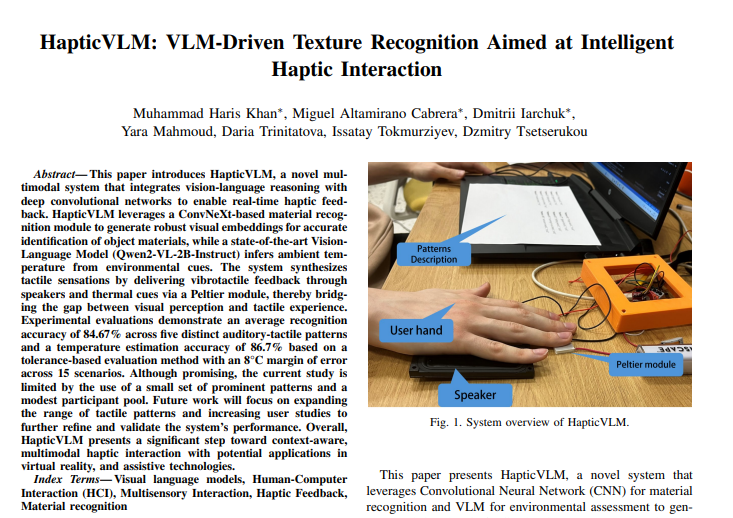Russia's HapticVLM System Stuns the World! 84.7% Tactile Recognition Accuracy Ushers in a New Era of Human-Computer Interaction
-
Tactile sensation, humanity's most primitive and direct way of perceiving the world, is being revitalized by technological advancements. While we still lament the lack of realistic touch feedback in virtual reality, a research team from Russia's Skolkovo Institute of Science and Technology has quietly rewritten this narrative. Their newly developed HapticVLM multimodal tactile system, with an astonishing material recognition accuracy of 84.7%, has set a new milestone in human-computer interaction technology.
The significance of this breakthrough far exceeds the numbers themselves. In the past, haptic feedback technology was often limited to simple vibration patterns, unable to accurately convey the true feel of different materials. The emergence of the HapticVLM system has completely overturned this situation, enabling machines for the first time to possess human-like material perception capabilities.
The technological core of the HapticVLM system lies in its sophisticated architectural design. The system ingeniously integrates deep convolutional networks with visual language reasoning technology, achieving seamless conversion from visual information to tactile feedback. The entire recognition process is as smooth as flowing water: the system first conducts deep scans of objects using the advanced ConvNeXt architecture, accurately identifying whether they are cold and hard like metal, warm and rustic like wood, or soft and delicate like fabric. Subsequently, the system generates highly robust visual embedding data, providing a solid foundation for subsequent material recognition.

Even more astonishing is that HapticVLM also possesses environmental awareness intelligence. Leveraging the latest Qwen2-VL-2B-Instruct visual language model, the system can intelligently infer ambient temperature conditions and seamlessly integrate this information into the tactile experience. This multi-dimensional perception capability brings virtual tactile experiences one step closer to the real world.
The revolutionary improvement in user experience is reflected in the system's meticulously designed dual-feedback mechanism. When a user's finger lightly touches a virtual object's surface, HapticVLM generates vibration feedback perfectly matched to the specific material through high-precision speakers. These vibrations are not simple mechanical oscillations but precisely calculated composite waveforms that accurately simulate the solidity of metal surfaces, the roughness of wood grain, and the smoothness of silk fabric. Every touch delivers a convincingly realistic sensation.
The addition of a temperature feedback system elevates the entire experience to new heights. Through integrated Peltier modules, HapticVLM can provide precise dynamic temperature changes, allowing users to genuinely feel the coldness of metal, the warmth of wood, or even the comforting heat of freshly baked bread. This meticulous temperature control, combined with perfectly coordinated vibrations and auditory feedback, creates an unprecedented immersive sensory world.
Experimental data fully validates the outstanding performance of the HapticVLM system. In comprehensive tests covering five different auditory-tactile modes, the system achieved an average recognition accuracy of 84.67%, a leading figure among similar technologies. Even more exciting is that in temperature estimation challenges across 15 complex environmental scenarios, the system demonstrated an exceptionally high accuracy of 86.7%, fully showcasing its powerful environmental perception capabilities.
Despite these impressive achievements, the research team maintains a scientifically rigorous attitude. They candidly acknowledge the current system's limitations and have outlined future development directions. The team plans to further expand the breadth and depth of tactile modes while strengthening user experience research to better serve practical human needs. This spirit of continuous improvement suggests that the HapticVLM system still has tremendous development potential.
The application prospects for the HapticVLM system are extremely broad, covering almost all digital scenarios requiring tactile interaction. In virtual reality games, players will be able to truly feel the sharpness of a sword's edge and the weight of armor. On online shopping platforms, consumers can experience the actual feel of products before purchasing. In telemedicine, doctors can perform more precise remote diagnoses through tactile feedback. In education and training, students can gain deeper understanding of physics and chemistry concepts through tactile experiences.
This technological breakthrough is not just an engineering success but represents humanity's deep exploration of digitizing sensory experiences. The advent of the HapticVLM system marks our entry into a new era of digital interaction, where the boundary between virtual and real becomes increasingly blurred, and human-computer interaction reaches unprecedented levels of natural harmony.
With continuous technological advancements and expanding application scenarios, we have every reason to believe that the tactile interaction technology represented by HapticVLM will become one of the foundational infrastructures of the future digital world. That digital future filled with realistic tactile sensations is coming our way.
Paper address: https://arxiv.org/pdf/2505.02569
